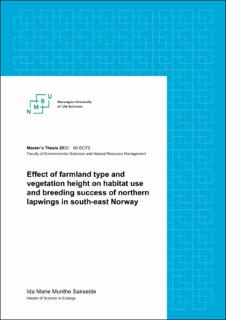Effect of farmland type and vegetation height on habitat use and breeding success of northern lapwings in south-east Norway
Master thesis
Permanent lenke
https://hdl.handle.net/11250/2724967Utgivelsesdato
2020Metadata
Vis full innførselSamlinger
- Master’s theses (MINA) [668]
Sammendrag
Habitat use is a key element to understanding how endangered species should be protected from further decline. The northern lapwing (Vanellus vanellus) is a red-listed farmland species threatened by multiple factors such as agricultural intensification, predation and environmental factors. Habitat use and hatching success was monitored frequently during the breeding season in 2019 in 28 localities in south-east Norway with known occurrence of lapwings. Lapwings preferred short vegetation and avoided tall vegetation, particularly as the breeding season progresses. They preferred short-height habitat types such as tilled fields, vegetation islands, roads and piles, and avoided tall-height habitat types such as autumn sown fields.
Out of 65 nests discovered in total, 50 % resulted in successful hatching whereas 30 % nests failed to produce chicks. Hatching success depended on habitat type selected for nest placement, but not vegetation height. Furthermore, results indicated that lapwings were more selective about their habitat after their chicks had hatched compared to the habitat chosen for nest placement.
Findings of this study suggest that the farmland landscape can be altered in order to increase hatching success. I recommend the following measured to prevent further population decline of lapwings in the study area: 1) switching from autumn sown cereals to spring sown cereals; 2) mark nests and avoid them during farmland activities; and 3) create set-asides and vegetation islands than may function as refuge from tall vegetation late in the breeding season.

